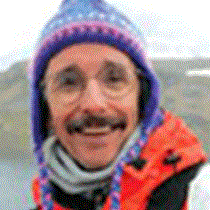Glacier Bay National Park
Our resident geologist, David Hirsch, reminded us the other day that geology is the study of not just rocks, but of time.
As we slipped quietly into Glacier Bay National Park to spend all day here, we enjoyed an abundance of time. Time on the bow and time on the stern. Time in the present and time in the past. Time in the sun and later, upon going ashore in Bartlett Cove this evening, time in the rain. A soft summer rain through a lavender sunset. We learned from National Park Service Ranger Sara Kiefer, who boarded the Sea Bird at 6:00 AM, that just 200 years ago Glacier Bay was all glacier and no bay. Imagine a river of ice one hundred miles long, ten miles wide, and thousands of feet thick that occupied this bay from about 1650 to 1750 AD. Then it retreated, and did so rapidly, shrinking back as much as a mile per year to unveil a new land, a gleaming sun-splashed geography out from under its cold sarcophagus. Reborn, and remarkably resilient, it is now home to a full panoply of wildlife, and we saw much of it: puffins, cormorants, gulls, and Steller sea lions at South Marble Island. A family of mountain goats on Gloomy Knob. An Alaskan coastal brown bear near Russell Island working his way along the beach fringe as if he owned the place; which he did. And still does. And will for a long time. That’s the beauty of designated wilderness. It belongs to the larger-than-human world. It’s the Earth as it was when we found it, not as it was after we finished with it. Man does not live in these places; he is only a visitor, as we were today, and grateful visitors at that.
By early afternoon we rounded Jaw Point and entered Johns Hopkins Inlet. Slowly the Sea Bird slalomed through a garden of icebergs until we stood one-quarter mile off the magnificent tidewater face of the mile-wide glacier. Gulls pin-wheeled off the ice front. Harbor seals moved through the chilly waters. A great slab of ice slid into the sea. As we turned to leave, the words of Dave Bohn came to mind from his acclaimed book, Glacier Bay: The Land and the Silence: “And now I understand. I understand all the old attempts at description. I understand why they were written and why they failed.”
Our resident geologist, David Hirsch, reminded us the other day that geology is the study of not just rocks, but of time.
As we slipped quietly into Glacier Bay National Park to spend all day here, we enjoyed an abundance of time. Time on the bow and time on the stern. Time in the present and time in the past. Time in the sun and later, upon going ashore in Bartlett Cove this evening, time in the rain. A soft summer rain through a lavender sunset. We learned from National Park Service Ranger Sara Kiefer, who boarded the Sea Bird at 6:00 AM, that just 200 years ago Glacier Bay was all glacier and no bay. Imagine a river of ice one hundred miles long, ten miles wide, and thousands of feet thick that occupied this bay from about 1650 to 1750 AD. Then it retreated, and did so rapidly, shrinking back as much as a mile per year to unveil a new land, a gleaming sun-splashed geography out from under its cold sarcophagus. Reborn, and remarkably resilient, it is now home to a full panoply of wildlife, and we saw much of it: puffins, cormorants, gulls, and Steller sea lions at South Marble Island. A family of mountain goats on Gloomy Knob. An Alaskan coastal brown bear near Russell Island working his way along the beach fringe as if he owned the place; which he did. And still does. And will for a long time. That’s the beauty of designated wilderness. It belongs to the larger-than-human world. It’s the Earth as it was when we found it, not as it was after we finished with it. Man does not live in these places; he is only a visitor, as we were today, and grateful visitors at that.
By early afternoon we rounded Jaw Point and entered Johns Hopkins Inlet. Slowly the Sea Bird slalomed through a garden of icebergs until we stood one-quarter mile off the magnificent tidewater face of the mile-wide glacier. Gulls pin-wheeled off the ice front. Harbor seals moved through the chilly waters. A great slab of ice slid into the sea. As we turned to leave, the words of Dave Bohn came to mind from his acclaimed book, Glacier Bay: The Land and the Silence: “And now I understand. I understand all the old attempts at description. I understand why they were written and why they failed.”




